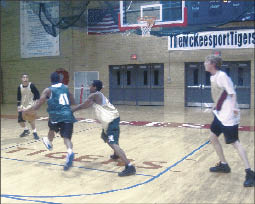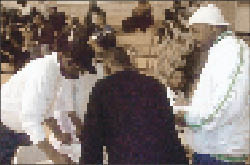 |
|
March Madness: Youths have a ball at the B2B tournament. |
If you try to call the nation’s official midnight basketball association, you sometimes get connected to Bryant Mortuary in San Francisco – which seems fitting, because most of the of country thinks midnight basketball is dead.
But while the nation has been awash in media coverage of this year’s NCAA tournament, some youth-serving agencies are quietly running midnight hoops, happy to be out of the national spotlight.
The latest contest was run by the Pittsburgh-based Community Empowerment Association (CEA), which says it drew 400 young people to its tournament last month in a McKeesport, Pa., high school gym. Such events remind us that more than a decade after midnight basketball was seemingly squashed as a national joke, many youth workers still believe that it has the power to steer young people from delinquency.
Getting kids off the streets at night for recreation is one of those youth work ideas that has enormous staying power as an effective practice, despite the absence of virtually any measurable evidence. Which is not to say it doesn’t work.
 |
|
Two-point play: Volunteers from B2B register young people for basketball and voting. |
Don’t forget that according to official history, basketball was invented in 1891 by physical education instructor James A. Naismith at a YMCA in Springfield, Mass. Many of today’s youth work administrators have seen its value first-hand: Lee Davis, the outreach coordinator at CEA, says that when he and his colleagues were growing up in the 1980s and 1990s, they had several late-night gym options available – typically at the Salvation Army or the YMCA.
So when Davis and Executive Director Rashad Byrdsong discussed possible outreach programs for at-risk youth, they decided the late-night games that they fondly remember might offer the right hook.
“A lot of youths aspire to be athletes,” Byrdsong said. “We use the athletics to generate interest, but throughout the basketball game we bring up academics and talk about economic development and getting jobs.”
The Association of Midnight Basketball Leagues Program (AMBLP) says recreation is only one of six components of an official program, the others being health, education, employment, cultural enrichment and case management. CEA’s tournament in March, and one a few months ago in the Pittsburgh suburb of Homewood, are part of its Brother2Brother Leadership Forum (B2B).
Rise and a Hard Fall
Midnight basketball was the response of G. Van Standifer, town manager of Glenarden, Md., to reports showing that most crimes in his community were committed between 10 p.m. and 2 a.m. by 17- to 25-year-olds. In 1986, he established the Midnight Basketball League (MBL), which required players to participate in nonviolence workshops and educational opportunities.
The program spread to more than 50 U.S. cities, including Chicago, Cleveland, Atlanta and San Francisco, garnering national media attention along the way. Standifer had the Midnight Basketball League name and logo trademarked and contracted with a manufacturer to supply official MBL uniforms. In April 1990, President George H.W. Bush recognized MBL as the 124th Daily Point of Light.
But in 1994, when President Bill Clinton cited MBL as an example of an effective violence prevention program worthy of federal funding, leading conservatives – most notably Rep. Newt Gingrich, (R-Ga.) – pounced on it as laughably wasteful liberal pork. Conservative talk show host Rush Limbaugh reflected the attitude when he mocked Clinton telling parents, “Hey, we solved your [delinquency] problem. We’re going to have your kids playing basketball midnight to 2 a.m.”
By the late 1990s, a decline in financial and political support at the federal and state levels led to the disappearance of many MBL programs.
Here and there, however, local nonprofits and recreation programs would run late-night basketball games to gets teens and young adults off the streets. In 2004, two men – West Coast teacher and coach Lawrence Gray Jr. and his business partner, Emanuel Hunt Jr. – obtained MBL’s trademark and reinvented the organization as the nonprofit Association of Midnight Basketball Leagues Program. Chapters must be nonprofits or municipalities, and pay annual dues of $250.
It’s a good bet, however, that the vast majority of midnight basketball programs are not affiliated with the AMBLP. The group has 10 active and nine pending chapters.
Gray, the CEO, said money is “really tight” at the organization, which operates virtually out of the businesses, homes and pockets of its small staff and board of directors. That’s why one of the phone numbers listed on AMBLP’s website connects callers to the mortuary, where a board member works and where Gray has an office.
Believers
When CEA set out to run midnight basketball, Byrdsong said, “We wanted to identify the hot spots for our events, where homicides were on the rise.” Those areas typically include several rival gangs.
Last month’s games were part of a two-day event, under the theme “All Guns Down: Jobs Not Jails.” It began at 8 p.m. on a Friday night with workshops that were led by B2B mentors and were required for participation in the games. The games ran from 10 p.m. to 2 a.m., featuring 30 teams.
“Everybody thought it was going to be a mistake” to draw rival gang members to the event, Davis said. “But … we had no problems. Not even an argument.”
Throughout the games, young people were encouraged to visit display tables to learn about apprenticeship and employment opportunities. Saturday afternoon featured a community rally and “speak-out” against violence.
As evidence that all this makes a difference, Byrdsong pointed out that McKeesport’s mayor attended the event, and that the chief of police said the event helped combat crime.
Such testimonials are about as far as the proof goes for midnight basketball. The exception is a 1995 University of Wisconsin study of the MBL in Milwaukee, which concluded that the program reduced crime by 30 percent in the target area during its first year, offered a safe haven for positive social activities, and significantly improved the educational and career aspirations of the participants.
Onlookers are also convinced of the idea’s value. Davis said several communities have contacted B2B about hosting more games. He has a “whole lineup” of events scheduled.
That was mixed news to Gray at the AMBLP. The CEA is not an association member, and the association’s attorney sometimes sends letters telling organizers of “Midnight Basketball” events that they can’t use the name without permission, because it is trademarked.
“What we’re trying to do is get people to join us, because they’re not supposed to be using our name without being a part of us,” Gray said. He wants everyone running such programs to follow the same general strategies.
Told about the CEA, Gray said, “Uh, can you have those guys call me?”
Contact: CEA (412) 371-3689, http://www.ceapittsburgh.org; AMBLP (415) 861-6986, http://www.amblp.com.
Anthony Glynn contributed to this report.
Jen Russell can be reached at jrussell@youthtoday.org.
























